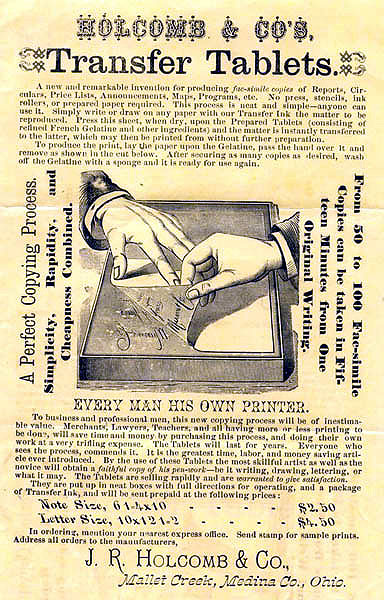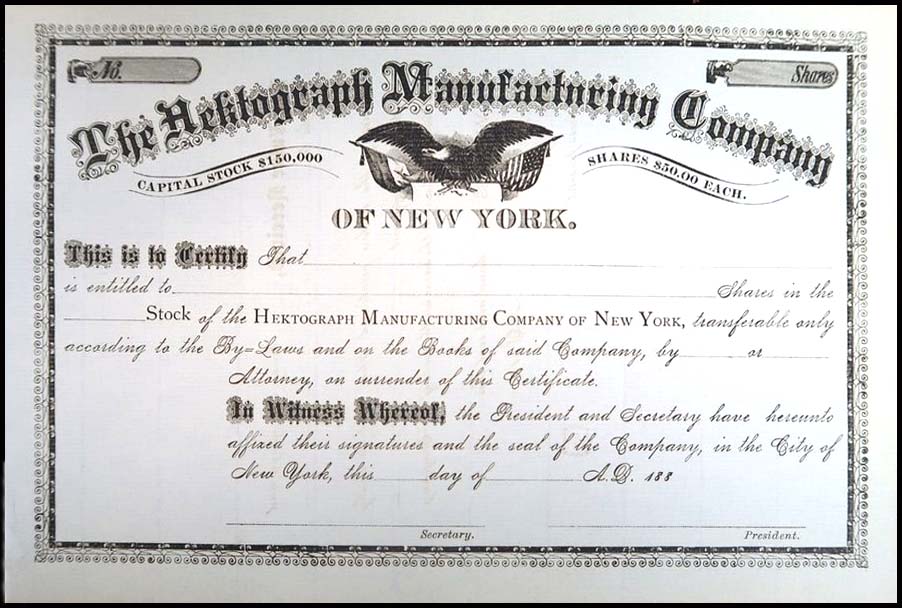hectograph on:
[Wikipedia]
[Google]
[Amazon]

 The hectograph, gelatin duplicator or jellygraph is a
The hectograph, gelatin duplicator or jellygraph is a
''The Scientific American Cyclopedia of Receipts, Notes and Queries'' (1901)
p. 261 Instructions and recipes for making a hektograph. {{Authority control Printmaking Printing devices

 The hectograph, gelatin duplicator or jellygraph is a
The hectograph, gelatin duplicator or jellygraph is a printing
Printing is a process for mass reproducing text and images using a master form or template. The earliest non-paper products involving printing include cylinder seals and objects such as the Cyrus Cylinder and the Cylinders of Nabonidus. The ...
process that involves transfer of an original, prepared with special inks, to a pan of gelatin
Gelatin or gelatine () is a translucent, colorless, flavorless food ingredient, commonly derived from collagen taken from animal body parts. It is brittle when dry and rubbery when moist. It may also be referred to as hydrolyzed collagen, coll ...
or a gelatin pad pulled tight on a metal frame.
While the original use of the technology has diminished, it has recently been revived for use in the art world. The hectograph has been modernized and made practical for anyone to use.
Process
The specialaniline
Aniline (From , meaning ' indigo shrub', and ''-ine'' indicating a derived substance) is an organic compound with the formula . Consisting of a phenyl group () attached to an amino group (), aniline is the simplest aromatic amine. It is an in ...
dyes for making the master image came in the form of ink or in pens, pencils, carbon paper, and even typewriter ribbon. Hectograph pencils and pens are sometimes still available. Various other inks have been found usable to varying degrees in the process; master sheets for spirit duplicators have also been pressed into service. Unlike a spirit duplicator master, a hectograph master is not a mirror image. Thus, when using a spirit duplicator master with a hectograph, one writes on the back of the purple sheet, using it like carbon paper to produce an image on the white sheet, rather than writing on the front of the white sheet to produce a mirror image on its back.
The master is placed on the gelatin and spirits applied to transfer the ink from the master to the gelatin. After transfer of the image to the inked gelatin surface, copies are made by pressing paper against it.
When a pad ceased to be useful, the gelatin could be soaked with spirits, the ink sponged away, and the pad left clean for the next master.
Storage
A grey-colored, thick, absorbent paper pad was supplied to cover the gelatin surface for storage. This also removed ink from the surface, but it took many hours to do so. Care needed to be taken that the gelatin surface was kept clean, and not damaged (e.g. by fingernails) during duplicating. Although the name "hecto-
''Hecto'' (symbol: h) is a decimal unit prefix in the metric system denoting a factor of one hundred. It was adopted as a multiplier in 1795, and comes from the Greek , meaning "hundred". In 19th century English it was sometimes spelled "hecato" ...
graph" implies production of 100 copies, in reality the gelatin process produced print runs of somewhere between 20 and 80 copies, depending upon the skill of the user and the quality of the original. At least eight different colors of hectographic ink were available at one time, but purple was the most popular because of its density and contrast.
Historical uses
Hectography, requiring limited technology and leaving few traces behind, has been deemed useful both in low-technology environments and in clandestine circumstances where discretion was necessary. In the earlier 20th century, the process lent itself to small runs of school classroom test papers, church newsletters andscience fiction fanzine
A science-fiction fanzine is an amateur or semi-professional magazine published by members of science-fiction fandom, from the 1930s to the present day. They were one of the earliest forms of fanzine, within one of which the term "''fanzine''" ...
s. Prisoners-of-war at Stalag Luft III (the scene of ''The Great Escape'') and at Colditz Castle during World War II
World War II or the Second World War (1 September 1939 – 2 September 1945) was a World war, global conflict between two coalitions: the Allies of World War II, Allies and the Axis powers. World War II by country, Nearly all of the wo ...
used an improvised hectograph to reproduce documents for a planned escape attempt.
The Communist authorities in the Jiangsu
Jiangsu is a coastal Provinces of the People's Republic of China, province in East China. It is one of the leading provinces in finance, education, technology, and tourism, with its capital in Nanjing. Jiangsu is the List of Chinese administra ...
–Anhui
Anhui is an inland Provinces of China, province located in East China. Its provincial capital and largest city is Hefei. The province is located across the basins of the Yangtze and Huai rivers, bordering Jiangsu and Zhejiang to the east, Jiang ...
Border Area of China
China, officially the People's Republic of China (PRC), is a country in East Asia. With population of China, a population exceeding 1.4 billion, it is the list of countries by population (United Nations), second-most populous country after ...
used the process for postage stamps in November 1948, produced in sheets of 35, with thirteen $50 values, six $100, twelve $200, two $300 and two $500 values.Stanley Gibbons
The Stanley Gibbons Group plc is a company quoted on the London Stock Exchange specialising in the retailing of collectable postage stamps and similar products. The group is incorporated in London. The company is a major stamp dealer and phila ...
Stamp Catalogue Part 17
It has also been used, though not very extensively, as an artistic medium in printmaking
Printmaking is the process of creating work of art, artworks by printing, normally on paper, but also on fabric, wood, metal, and other surfaces. "Traditional printmaking" normally covers only the process of creating prints using a hand proces ...
. The Russian Futurists used it for book illustrations, and the German expressionist Emil Nolde made four hectographs.
Stephen King
Stephen Edwin King (born September 21, 1947) is an American author. Dubbed the "King of Horror", he is widely known for his horror novels and has also explored other genres, among them Thriller (genre), suspense, crime fiction, crime, scienc ...
, in his book '' On Writing'', writes of how he and his elder brother Dave used the process to create their newspaper, ''Dave's Rag''.
It was also used in professional situations; in Macy's advertising department during the 1950s and 1960s, full-page newspaper ad layouts were drawn with hectograph pencils and then duplicated on a hectograph to make file copies for future reference. Before the popularization of spirit duplicators and the mimeograph, there were mechanized hectography machines that used a drum, rather than a simple flat tray of gelatin.
In fiction
In the final chapters of '' The Pothunters'' by P. G. Wodehouse the major characters use a jellygraph to produce a school magazine at very short notice. Wodehouse assumes his reader knows exactly what a jellygraph is and alludes to its being unattractive: "This jelly business makes one beastly sticky. I think we'll keep to print in future."George Orwell
Eric Arthur Blair (25 June 1903 – 21 January 1950) was an English novelist, poet, essayist, journalist, and critic who wrote under the pen name of George Orwell. His work is characterised by lucid prose, social criticism, opposition to a ...
's '' Keep the Aspidistra Flying'' (1936) describes a somewhat more subversive schoolboy publication:
See also
* Spirit duplicator * Duplicating machines * List of duplicating processesReferences
External links
''The Scientific American Cyclopedia of Receipts, Notes and Queries'' (1901)
p. 261 Instructions and recipes for making a hektograph. {{Authority control Printmaking Printing devices